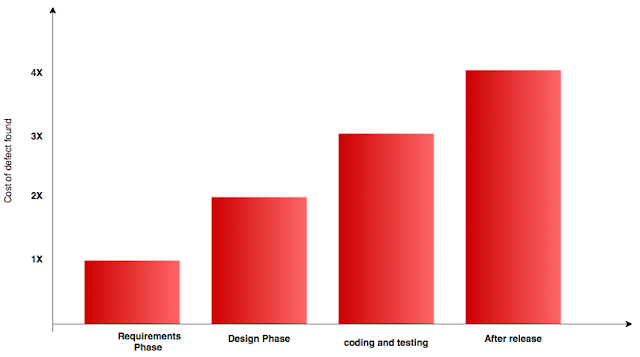Every software development needs coding; without it, nothing can be developed. The quality of the software depends on the way its developers write code. It’s an essential part of the system and the behavior of the system depends on it. A small mistake in coding may make the software vulnerable and unstable.
Quality engineering works hard to find bugs to avoid potential problems with the software. QA engineers spend numerous hours and put tremendous effort into finding any problems with the software and reporting it to the developers.
Cost of fixing the defects at various level.

The cost of fixing defects at a latter stage increases exponentially; hence, you need more hours of QA engineers and developers to fix and run the entire release cycle again. If we can save some amount of time and effort, we can utilize resources in a more productive way.
Can we make sure code is better-written, more tightly secure and has no potential bugs, and the right libraries are used?
If we can implement it, we can at least make sure developers are checking to make sure there is less friction in the code?
Here are few checks that can be implemented during creation or before passing code to QA to ensure it’s less buggy.
Code Review
In code review, the coder sends it to someone else for the review. It’s really a great way to verify the written code by a second pair of eyes to catch any glitch, logic or possible mistakes overlooked by the coders.
This is part of the development process to make sure nothing is released without a second opinion. There are many ways and tools available to perform code review. These can be implemented and integrated with the source control tool. More on code review and details can be found here.
Unit Test
Unit testing tests a piece of the code by writing small code around it via supporting data and mocking it to test scenarios. It commonly is written by developers during the development, then run during source code compilation or independently according to various languages.
This testing provides extra early warning to find problems before handing it off to quality check. Unit test coverage could provide details on how much has been covered by unit test cases. There are many ways to figure out the coverage.
Static Code Analysis
Static code analysis is the way to analyze at a very basic level without running the software or performing any testing. It can be done at compilation time or at development time by using client-side tools.
Analysis tools look for any possible or hidden bugs, such as never-ending loops, or programming flaws. These tools do analysis based on a similar pattern but each in a slightly different way.
Coding Guideline
Each developer may write code in his/her own style with varying degrees of differentiation. This may create big problems when it comes to handing over of a project to different teams or coders. It may take tremendous amount of time to understand what’s been written by somebody else.
To reduce this potential headache, organization may implement a coding guideline, or style of writing code for developers, to make sure everybody follows one systematic way that can be understood easily by other team members. There are different tools available for various coding languages.
Library Check
Open-source projects and other freely available tools in GitHub are making life easier for developers to use them in their projects as libraries. At same time, they can introduce several other problems with the software if libraries are not tested properly, including security vulnerabilities, untested components or licensing issues.
There are many tools to help developers to verify their libraries.
In Summary
There may be many other verifications and checks required by an organization. Above are the very basic checks that can be implemented during the development phase to rule out any discrepancies related to security or legal issues. Checks could be implemented at the client side, where developers write code or during the continuous integration phase.
There are many tools available in the market or the open-source community that can be used to verify and secure code to avoid unrealized bugs. It’s in the best interest of any organization to keep its software bug-free and reduce the amount of unnecessary resources working on such issues that could be caught early.
Other References – http://www.scmtechblog.net/2016/08/code-quality-check.html




